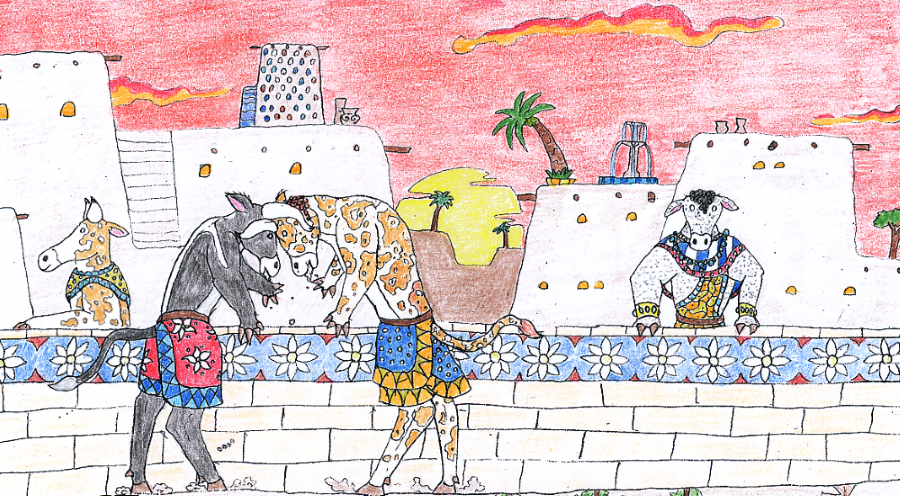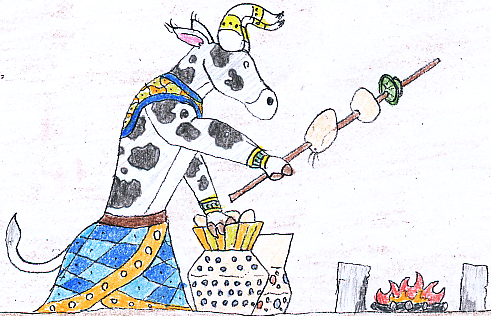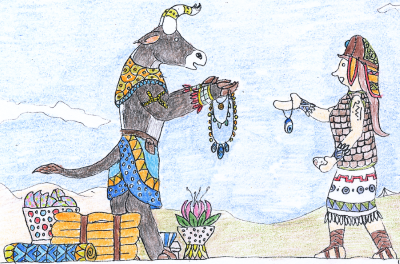Minotaurs
The Minotaurs1 are bovine people who inhabit the Southern Desert, either as semi-nomadic tribes travelling between oases or within towns and cities around Ymn Lake. They are distant relatives of the wild cattle endemic to Nep Peninsula and Erenere Archipelago in southeastern Dragonía.
It wasn't until 262 a.Dr that the Minotaurs made contact with other people, namely the Þrihaks, with whom they soon established trade routes, selling darg roots, glass beads and cloth in exchange for goods coming as far away as the Ameders to the north.
Despite this, few Minotaurs have ventured further than Þrihakía, as the climate of the Plain of Kings (Úlomnaat köf in Minotaur tongue) is too cold for them to handle. Conversely, their civilization has become the stuff of legends among the Þrihaks and Mörkels.
Chiefs earn their title by challenging their father to a duel via butting their heads and winning -a tradition practiced by the desert tribes as well-, and once one of their own sons manages to do so as well, the old chief resigns and serves as an adviser instead.
Disputes in general among men are resolved by butting heads as well.
While monogamy is the norm among Minotaurs, women are allowed to marry two men, provided that they've fought for her for a long time and shown to be of equal strength, which is considered a great honour for both men involved.
After being chosen, the man visits the woman's parents to (hopefully) receive their approval. Traditionally, he must fulfill a task given by each parent; answer a riddle correctly for the mother, and manage to lift the father off the ground.
The marriage ceremony itself is quite simple. The couple sits down, feed each other bits of food from a bowl, and give promises of love and respect, after which they are given the distinctive headgear of a married couple. Married Minotaurs are forbidden to participate or even watch duels.Apparel
Minotaur clothing mostly consists of a wrap-around skirt (similar to that of Mörkels and Þrihaks) and a wide cloth collar around the neck, sometimes large enough to resemble a poncho of sorts. Blue is preferred, as that colour is associated with fertility and protection from evil spirits.
Appearance and abilities
Minotaurs are the only extant bipedal cattle in Dragonía, but closely resemble their quadrupedal cousins in most respects, although their hide is generally more colourful. They have four claw-like hooves on each hand, with a pair of claws acting as opposable thumbs. Minotaurs are partially colourblind, their vision being limited to blue and yellow hues, and thus these colours are predominant in their clothing, art and architecture.History
The first Minotaur societies appeared around 35.000 b.Dr, when what is currently the Southern Desert was a vast grassland, but their territory gradually shrank as the increasingly arid climate transformed the region into a savanna and finally a desert. The tribes thus lived in isolation around Ymn Lake and around the nearest oases for millennia, first as gatherers and after 600 b.Dr. as farmers.It wasn't until 262 a.Dr that the Minotaurs made contact with other people, namely the Þrihaks, with whom they soon established trade routes, selling darg roots, glass beads and cloth in exchange for goods coming as far away as the Ameders to the north.
Despite this, few Minotaurs have ventured further than Þrihakía, as the climate of the Plain of Kings (Úlomnaat köf in Minotaur tongue) is too cold for them to handle. Conversely, their civilization has become the stuff of legends among the Þrihaks and Mörkels.
Society
Government
Minotaurs at the shores of Lake Ymn are divided into a number of city-states, each ruled by a chief belonging to a dynasty named after its founder; the Esónimúrrú Dynasty which rules the city of Limaak, for example, is named after Sonim II.Chiefs earn their title by challenging their father to a duel via butting their heads and winning -a tradition practiced by the desert tribes as well-, and once one of their own sons manages to do so as well, the old chief resigns and serves as an adviser instead.
Disputes in general among men are resolved by butting heads as well.
Marriage
Butting heads is not limited to politics and disputes though, as they form an important part of Minotaur courtship as well. In each town and city there's at least one arena of sorts, marked by a low wall, where young men take turns dueling each other and (hopefully) attract the attention of unmarried women. Sometimes a man will declare for whom he fights for, if she likes him then she'll keep watching, otherwise the woman turns her back on him.While monogamy is the norm among Minotaurs, women are allowed to marry two men, provided that they've fought for her for a long time and shown to be of equal strength, which is considered a great honour for both men involved.
After being chosen, the man visits the woman's parents to (hopefully) receive their approval. Traditionally, he must fulfill a task given by each parent; answer a riddle correctly for the mother, and manage to lift the father off the ground.
The marriage ceremony itself is quite simple. The couple sits down, feed each other bits of food from a bowl, and give promises of love and respect, after which they are given the distinctive headgear of a married couple. Married Minotaurs are forbidden to participate or even watch duels.
Culture
Apparel
Minotaur clothing mostly consists of a wrap-around skirt (similar to that of Mörkels and Þrihaks) and a wide cloth collar around the neck, sometimes large enough to resemble a poncho of sorts. Blue is preferred, as that colour is associated with fertility and protection from evil spirits.
Men often adorn their horns with gold jewelry or paint them in bright colours, but most Minotaurs wear bracelets or necklaces of some sort, usually decorated with semiprecious stones, glass beads, chitin or imported feathers of Rekan Birds.
Art
Architecture
Minotaur towns and cities have a very different layout compared to those in other Dragonían cultures; mudbrick houses are clustered together and the flat rooftops are effectively streets, connected by a network of stairs and ladders. Only palaces and a few structures such as arenas and wells are at ground level.
Homes are generally small and entered through holes in the ceiling via ladders, which are removed during the night for privacy. They are mostly used for eating and sleeping, as most other tasks are done outside due to poor ventilation.
The outer walls of shrines and palaces are often studded with clay cones, whose circular bases form colourful patterns, while floors are sometimes adorned with glass mosaics.
Cuisine
Being bovines, Minotaur diet is completely vegetarian, mostly consisting of Darg Roots and other tubers, lettuce, water lilies and other aquatic plants. Common drinks include coconut milk, fermented Anma Cacti juice, and the sweet sap gathered from crushed stalks of a plant known as Gúat. The stalks themselves are popular snack.
Most food is eaten fresh or roasted and served on plates or in small bowls, either made of clay or glass.
Language
The Minotaurs speak about a dozen languages of varying intelligibility, with those used by the desert nomads being most divergent. Most Minotauric languages are tonal and make distinction between long and short wovels. The nomads also switch to a creole language when speaking with the Þrihaks or Siimakú to the north, and some tribes have adopted a few word from the latter as well.
A number of different writing systems are used around Ymn Lake, all of which make extensive use of dots and straight lines. The main writing implements are clay tablets and reed pens.
Magic studies
Sensitivity to magic is considered a gift from the gods, so every Minotaur who does so is forced leave their family for good, undergo training by a shaman and devote their life to heal others in exchange for a bit of food. Shamans are generally pitied rather than respected, and are often referred to as the empty handed ones.
Religion
Minotaurs are polytheists, and their pantheon numbers around 20.000 deities, though a vast number of them are merely local names for a few gods and goddesses. The most important of these the god of the sky and goddess of the earth, which most of the desert tribes worship exclusively, while the people around Ymn Lake also venerate deities of fertility, the underworld, sun, moon and water.
The gods are worshipped either by prayers or by offering incense in one of myriad tiny shrines found throughout cities and along roads.
Funerary rites
The underworld is described as a dreadful place in Minotaur mythology, where souls of the dead wander around in darkness, with dust and clay as their only sustenance. Common burials are the norm, with bodies lying on their stomach and arranged so that they hold hands and thus will have each others company in the underworld.
Warfare
Warfare is unknown in Minotaur society, as all disputes are resolved with good old-fashioned head-butting if they cannot be resolved by words alone.
1Original icelandic: Mínótárar, singular: Mínótár






Comments